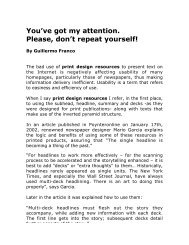Framing Differences 1 Framing Differences in Gender-Related Sport ...
Framing Differences 1 Framing Differences in Gender-Related Sport ...
Framing Differences 1 Framing Differences in Gender-Related Sport ...
- No tags were found...
You also want an ePaper? Increase the reach of your titles
YUMPU automatically turns print PDFs into web optimized ePapers that Google loves.
<strong>Fram<strong>in</strong>g</strong> <strong>Differences</strong> 17than those <strong>in</strong> newspapers (41.9%). Of course, the surpris<strong>in</strong>gly few total number of byl<strong>in</strong>earticles on the U.S Open published on the three Internet (n=56) sites may have skewedthose differences, s<strong>in</strong>ce all six newspapers and onl<strong>in</strong>e outlets exam<strong>in</strong>ed provided morecoverage on each of the f<strong>in</strong>al four days of tournament play than each of the previous 10 –a time when Federer’s dom<strong>in</strong>ance became a more significant news storyOverall, neither the content with<strong>in</strong> newspapers nor with<strong>in</strong> the onl<strong>in</strong>e sport sitesgreatly differed from previous research; and both obviously placed a premium on men’stennis based on total number of articles published. However, the b<strong>in</strong>omial tests for twoproportions revealed startl<strong>in</strong>g differences between how newspapers and onl<strong>in</strong>e sitesframed female athletes. In compar<strong>in</strong>g articles solely on women’s tennis, newspapers weresignificantly more likely to use descriptors on perceived athletic weaknesses, family rolesor relationships, and physical appearances. Onl<strong>in</strong>e articles were more likely to <strong>in</strong>cludedescriptors on positive skill level and psychological strengths.These results show that onl<strong>in</strong>e sport news sites for at least the three major outletsexam<strong>in</strong>ed <strong>in</strong> this study were more likely to alter and challenge the traditional genderstereotypes that have historically been framed through sport media coverage (Kane, 1996;Higgs, Weiller, & Mart<strong>in</strong>, 2003). In contrast, newspapers were significantly more likelyto frame female athletes more negatively, while also delv<strong>in</strong>g <strong>in</strong>to their personal lives andelaborat<strong>in</strong>g on their appearances more than the onl<strong>in</strong>e sites. Therefore – at least <strong>in</strong> regardto the new media outlets – hegemonic mascul<strong>in</strong>ity was both support and challenged, andthus rema<strong>in</strong>s contested (Connell, 2005). Furthermore, based on these results, onl<strong>in</strong>e sportmedia appears far more likely to challenge the status quo for fram<strong>in</strong>g female and male





